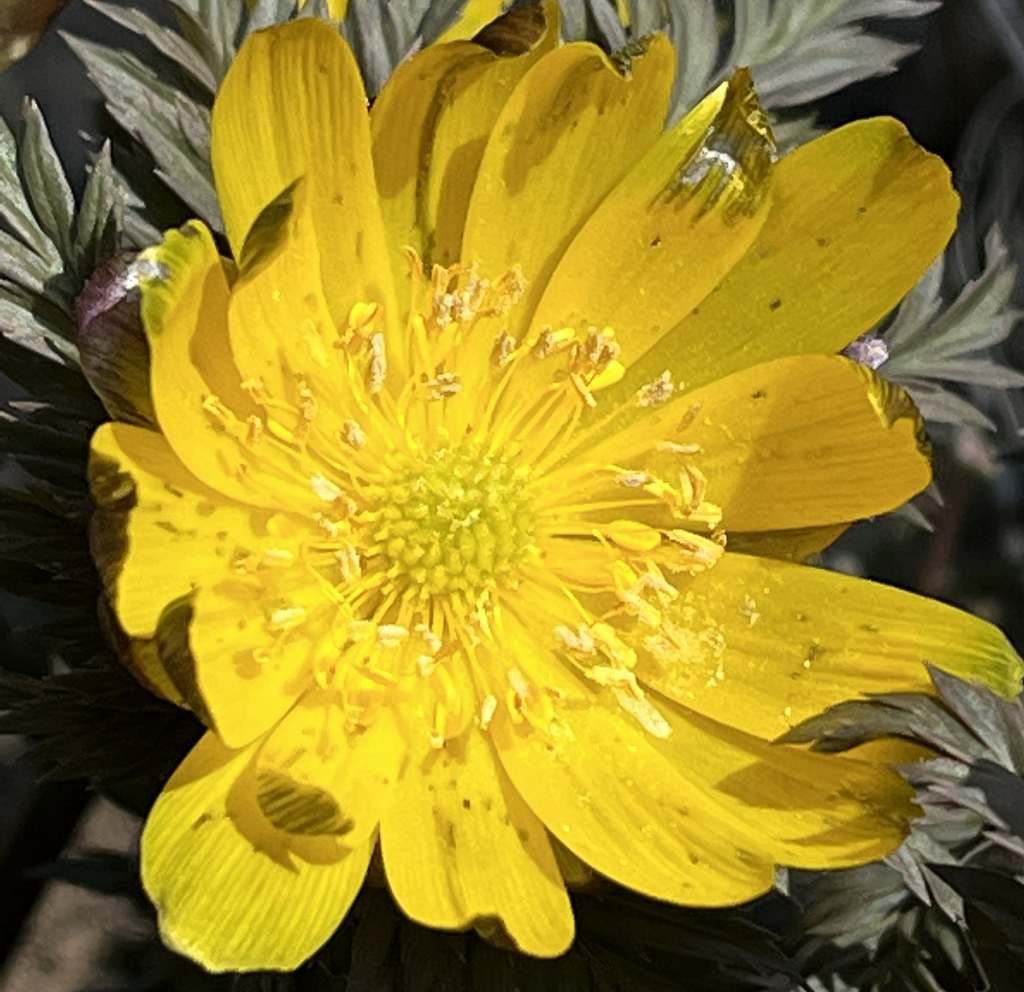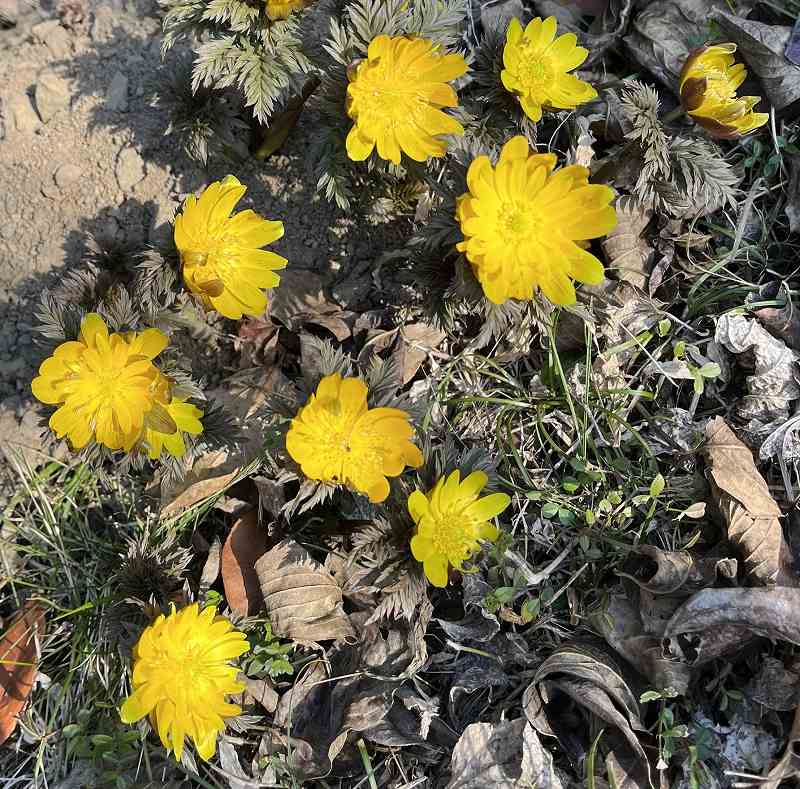フクジュソウは黄金色の花を咲かせます。花言葉は「幸福を招く」「永久の幸福」「祝福」「思い出」。文字通り、おめでたい長寿の花です。
Adonis ramosa blooms golden flowers. The flower language is “invite happiness,” “eternal happiness,” “blessing,” and “memories.” Literally, it is a flower of longevity that you wish to congratulate.
【仮名】フクジュソウ, ケンサイギク
【和名】福寿草, 献歳菊
【英名】Adonis Ramosa
【学名】Adonis ramosa
【誕生】01/ 01, 01/ 04, 02/ 26, 04/ 06
【開花】02, 03月
【花色】Yellow



フクジュソウ
フクジュソウの分類
フクジュソウはキンポウゲ科の多年草。ヨーロッパからアジアにかけて自生し、日本では北海道、本州、四国に分布しています。属名(アドーニス)はギリシャ神話に登場する美少年の名前に由来し、種名(ラモサ)は「枝分かれした」という意味。和名の別名も「枝打福寿草」です。
フクジュソウの名前
フクジュソウは江戸時代、早春におめでたい黄金色の花を咲かせることから、「福告ぐ草」と呼ばれました。しかし、語呂が悪いので、真ん中が「告ぐ」から「寿」へと差し替え。花が長く咲くことから長寿の意味もあります。旧正月に咲くので、「元日草」「朔日草」という別名も。
フクジュソウの生育
フクジュソウは春、苞に包まれた短い茎の上に、花だけが着きます。茎が伸びて枝分かれしつつ、細かく裂けた葉が鞘状から互生で展開。花が咲く位置も高くなっていきます。地上部の光合成で地下部の根茎がしっかり肥厚。しかし、夏には葉を枯らし、秋から冬にかけて休眠します。
フクジュソウの花
フクジュソウの花は陽が当たって暖かくなると開き、日暮れや夜間、曇天で寒くなると閉じます。虫媒花ですが花蜜はなく、開花も虫の少ない寒い時期。そのため、花弁で日光を花の中心に集め、その熱で虫を誘引します。花言葉は「幸福を招く」「永久の幸福」「祝福」「思い出」。
フクジュソウの毒性
フクジュソウは毒性のある強心配糖体の「シマリン」や「アドニトキシン」を全草に含有。誤食すると少量でも嘔吐、呼吸困難、心臓麻痺などで死亡することがあります。根茎を乾燥したものは生薬「福寿草根」ですが、安易な利用は禁物。新芽もフキノトウと間違えられて危険です。
フクジュソウの近縁種
フクジュソウには近縁種があります。「北見福寿草」は北海道東部に自生し、ロシア、朝鮮半島にも分布。多毛で茎は中実です。「陸奥福寿草」は東北から九州にかけて分布。萼が短く、花弁の半分くらいで、茎は中空です。「四国福寿草」は四国と九州に分布。無毛で茎は中空です。
Adonis Ramosa
Adonis ramosa is a perennial plant of the family Ranunculaceae. It grows naturally from Europe to Asia, and is distributed in Hokkaido, Honshu, and Shikoku in Japan. The genus name (Adonis) is derived from the name of a young boy in Greek mythology, and the species name (Ramosa) means “branched”. Another name for the Japanese name is “Edauchi Fukujusou”.
Adonis ramosa was called “Fortune-telling grass” because it blooms golden flowers in early spring in the Edo period. However, because the pun is bad, the middle is replaced from “tell” to “Kotobuki”. Since the flowers bloom for a long time, it also means longevity. Since it blooms in the Chinese New Year, it is also known as “Ganjitsusou” and “Tsuitachisou”.
In spring, only flowers of Adonis ramosa arrive on short stems wrapped in bracts. The stems grow and branch, and the finely split leaves develop alternately from the pod shape. The position where the flowers bloom will also increase. Underground rhizomes are thickened by photosynthesis above ground. However, it withers its leaves in summer and is dormant from autumn to winter.
Adonis ramosa flowers open when the sun is shining and warm, and close when it gets cold at nightfall, at night, or in cloudy weather. Although it is an entomophily, there is no nectar and it blooms in the cold season with few insects. Therefore, the petals collect sunlight in the center of the flower, and the heat attracts insects. The flower language is “invite happiness,” “eternal happiness,” “blessing,” and “memories.”
Adonis ramosa contains the toxic cardiac glycosides “cymarin” and “adnitoxin” in its whole plant. If you accidentally eat it, even a small amount may cause vomiting, respiratory distress, or heart attack. The dried rhizome is the crude drug “Adonis ramosa”, but it should not be used easily. Sprouts are also dangerous because they are mistaken for Fukinoto.
Adonis ramosa has related species. “Kitami Fukujusou” grows naturally in eastern Hokkaido and is also distributed in Russia and the Korean Peninsula. It is hairy and has solid stems. “Michinoku Fukujusou” is distributed from Tohoku to Kyushu. The calyx is short, about half the petals, and the stem is hollow. “Shikoku Fukujusou” is distributed in Shikoku and Kyushu. It is hairless and has a hollow stem.


